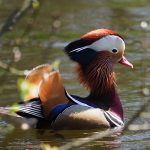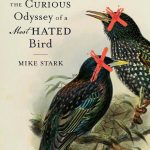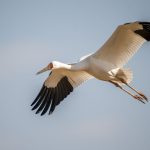I always take the Winter Finch Forecast with a grain of salt. It’s like a Farmer’s Almanac for predicting what wildlife will do and if there’s anything that is predictable about wildlife it’s that ultimately, it’s unpredictable. But it seemed to say that we may have finches coming down into the US this year…and boy howdy, that looks to be the case.
“Winter finch” is kind of a catchall term that can include redpolls, siskins, grosbeaks and crossbills. We usually have a bit of Pine Siskin action around my area and I noticed an influx of Pine Siskins around my beehives two weeks ago. If you have bird feeders and you have large flocks of goldfinches, look closely at all the dull olive birds with hints of yellow. Note if any of them are super streaky, the streaky ones with splashes of yellow on the wings are Pine Siskins.
The other day I was doing an eagle survey in southern Minnesota among some combined cornfields and I was mentally noting birds calling around me, “Horned Lark…Savanna Sparrow…American Pipit…Lapland Longspur…White-winged Crossbills…wait, what the what? Crossbills?”
I turned around and realized that the farmhouse behind me had a wind break of pine trees with untapped cones and White-winged Crossbills were all over it. I also remembered that my birding friends on Facebook and Twitter had been reporting Common Redpolls and Evening Grosbreaks. So, if you have noticed this and wondered, how can I get in on some of this finch action, consider your bird feeder…and also your seed budget.
The most economical way to go is to offer black oil sunflower seed, it will give you the most birds for your buck (the above Evening Grosbeaks were chowing down on this feeder at Sax Zim Bog last winter). Sunflower used to be dirt cheap but because companies like Frito Lay switched to sunflower oil and more farmers are growing corn for the subsidies, less sunflower is available for use as bird seed and the price skyrocketed. However, in general it is cheaper than a seed mix that is mostly sunflower. Be very careful in late autumn of sunflower seed being sold at an extreme discount. Unless you are purchasing directly from a farmer, the chances are good that the super cheap seed is one to two years old and though edible, it’s not as desirable as fresh seed as the nut meat shrivels and it could be chock full of Indian Meal Moth larvae or other seed pests. Don’t believe me? Check out what happened when a retired USDA Seed Researcher decided to test out what I said.
Another very popular offering that this Common Redpoll and American Goldfinch are enjoying is sunflower seed out of the shell. This stuff is great because it doesn’t leave a shell mess and if any falls to the ground without being eaten, it won’t germinate. However, sunflower seed out of the shell is very expensive and can be twice the price of sunflower seed in the shell. Also, starlings are physically incapable of opening up sunflower seed shells (they may sift through it, but they cannot crack it open). Once sunflower is out of the shell, starlings can chug it down like nobody’s business. So if you live someplace that is starling free (ha!) and have an unlimited seed budget, consider sunflower out of the shell.
There’s always Nyjer aka thistle to offer birds like siskins, redpolls and goldfinches. This is one you want to be careful when purchasing. If Nyjer is over six months old, finches do not eat it. It’s important to purchase this in small quantities and purchase often. Sometimes you will see deals on Nyjer this time of year and it may seem like a great idea to purchase now at a lower price per pound to get you through the winter finches. However, you can’t be sure how old that seed is when you purchase it. It may very well already be over three months old and not as desirable to the finches come February. If you notice that there has been a big decline in finches coming in for your finch feeder, ask yourself when was the last time your purchased fresh seed. Chances are it’s too old for the finches to have any interest in it.
Don’t forget that if you get cool winter finches at your feeder like this Pine Grosbeak to report them to eBird. If you’re not sure if finches are near you, check out the eBird range maps on the website or by using the BirdsEye app on a smartphone. If they are reported in your area, have some fresh seed ready to go!

















My parents buy huge quantities of nyger and shelled sunflower seeds for their finches. Even though they are in the natural range of starlings, they never seem to be a problem. We never saw siskins until they started with the nyger, but we never get some of the more unusual finches like Linnet or Twite.
Over here in the UK we currently have an irruption of Waxwings – they’ve come from Scandinavia where the berry crop has failed. It’s also a good year for Siskins and Redpolls. You reckon the ‘irruptions’ in N. America & Europe are connected?
I’m well inland in York and yesterday there were 300 + Waxwings in the city centre! More details, pics and related posts here if anyone is interested
http://timbobagginsabroad.blogspot.co.uk/2012/11/waxwing-invasion-gathers-strength-in.html
Thanks for this. I had a large flock of goldfinches feeding at some dry wild flowers in my Santa Cruz, Ca backyard. I couldn’t figure out why they weren’t coming to the feeder where I could get a good look at them. It turns out my Nyjer is just about 7 months old!
I agree with the importance of fresh seed when feeding any birds. We keep the freshest seed in our feeders by always getting it from our birding website, and it really makes a difference. Many store bought seeds can be sitting on the shelf for a month or two before anyone buys it – sometimes longer. So, you could already be buying old seed to feed your wild birds.
Please feel free to browse our very organized bird seed selection for all the different bird seeds you need at: http://www.backyardbirdparadise.com/bird__wildlife_feed.html
Enter “Blog” in the promo code box at check out for 10% off!